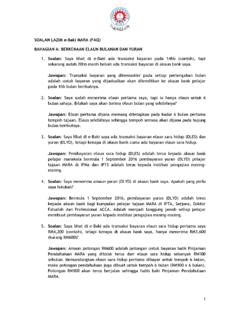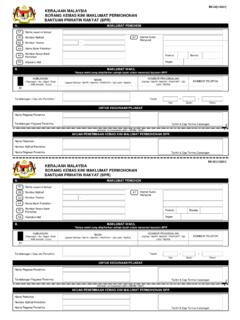Transcription of The socioeconomic impacts of COVID-19 in Malaysia: Policy ...
1 The socioeconomic impacts of COVID-19 in Malaysia: Policy review and guidance for protecting the most vulnerable and supporting enterprises Lin Lean Lim i Table of contents Page Introduction 1 Part 1 The socioeconomic impacts and the Prihatin economic stimulus package 4 The socioeconomic impacts : Available information 4 The Prihatin economic stimulus package: Review and reactions 17 Part 2 Identifying the most vulnerable 27 Who are the most vulnerable workers? 27 The characteristics that exacerbate vulnerability 39 Gender 40 Age 43 Migrant status 49 Part 3 Policy considerations and guidance 54 Protecting the most vulnerable: Social protection 57 Protecting jobs: Employment retention and creation 64 Immediate action: Employment retention 64 The recovery phase: Employment creation 65 Supporting SMEs and micro enterprises 70 Building back better 76 References 80 ii Appendices 1.
2 Stimulus package measures announced by Prime Minister Tan Sri Muhyiddin Yassin 92 2. Highlights of the additional Prihatin SME economic stimulus package 96 3. Official national SME definition 98 4. The ILO Policy framework to fight COVID-19 based on international labour standards 99 Table 1. Projection of macroeconomic impacts in 2020 .. 4 Table 2. World Bank projections (annual percentage change) .. 7 Table 3. Impact on service SMEs .. 8 Table 4. Impact on vulnerable communities .. 8 Table 5.
3 Effects on the economy and individuals: DOS online survey round .. 9 Table 6. Effects on the economy and individuals: DOS online survey round .. 12 Table 7. Impact on manufacturing enterprises .. 14 Table 8. Impact by industry .. 15 Table 9. The latest labour force statistics .. 16 Table 10. Employed persons by status in employment 2018 and 2019 .. 28 Table 11. Employment in the informal sector 2017 .. 29 Table 12. Impact of the crisis on the hardest hit sectors .. 33 Box 1. Bank Negara Malaysia Outlook for 2020 .. 6 iii Abbreviations ALMP Active Labour Market Policy BPN Bantuan Prihatin Nasional BSH Bantuan Sara Hidup CCM Companies Commission of Malaysia CMCO Conditional Movement Control Order CSO Civil Society Organization DOS Department of Statistics EIIP Employment-Intensive Investment Programme EIS Employment Insurance System EPF Employees Provident Fund ERP Employment Retention Programme FMM Federation of Malaysian Manufacturers FMT Free Malaysia Today GDP gross
4 Domestic product GGGI Global Gender Gap Index HRDF Human Resource Development Fund ICLS International Conference of Labour Statisticians ILO International Labour Organization IRB Inland Revenue Board IR4 Industrial Revolution ISIS Institute of Strategic and International Studies MCO Movement Control Order MDEC Malaysian Digital Economy Corporation MEF Malaysian Employers Federation MITI Ministry of International Trade and Industry iv MOHR Ministry of Human Resources MRC Migrant Worker Resource Centre MTUC Malaysian Trades Union Congress NESDC National Entrepreneur and SME Development Council PEP Public Employment Programme PLI poverty line income PPR Projek Perumahan rakyat PUI Person Under Investigation SME small and medium-sized enterprise SOCSO Social Security Organization SOP Standard Operating Procedure UNDESA United Nations Department of Economic and Social Affairs UNDS United Nations Development System WAO Women s Aid Organization WEF World Economic
5 Forum WIEGO Women in Informal Employment Globalizing and Organizing WSP Wage Subsidy Programme 1 The socioeconomic impacts of COVID-19 in Malaysia: Policy review and guidance for protecting the most vulnerable and supporting enterprises Introduction The COVID-19 pandemic has evolved into a health, socioeconomic and humanitarian crises of unprecedented scale and impact. The situation in Malaysia is compounded by the fact that the Government came into power only in early March of 2020 and is already facing a heavy debt problem, financial constraints, plummeting oil prices and knock-on effects on trade and tourism from the global shut down.
6 On the pandemic front, the Government has received international recognition for its efforts regarding testing, contact tracing, quarantine, and treatment, while keeping first responders safe and providing reliable information and advice to the public. Daily updated information on the numbers and rates of infection, fatalities and recoveries and identification of hot spots track progress in flattening the curve . To break the transmission by restricting movement and contact, the Government imposed a Movement Control Order (MCO) starting 18 March and extended to 12 May 2020.
7 The MCO imposed stay-at-home orders, banned outdoor activities including interstate travel and shut down all businesses except a few designated essential services and the natural resource sectors. A decision to significantly relax the regulations by 4 May 2020 under a Conditional Movement Control Order (CMCO) raised concerns that this could lead to another spike in infections. The CMCO was extended to 9 June, with almost all economic activities and public movements allowed but under strict health and safety Standard Operating Procedures (SOPs).
8 On the economic front, the lockdown is turning into an economic knockout. The economy is nosediving with intensifying negative impacts on jobs, incomes and 2 livelihoods, disrupting supply chains and upending businesses, and exacerbating inequalities, poverty and hardships especially among the most vulnerable. The Government has made available several economic stimulus measures intended to preserve rakyat s welfare, support businesses and strengthen the economy . In announcing the Prihatin rakyat (Caring for People) package on 27 March 2020, the Prime Minister emphasized that no one would be left behind.
9 1 On 6 April 2020, the Prime Minister announced an additional stimulus package aimed at support for small and medium-sized enterprises (SMEs) and micro businesses which, according to him, account for two-thirds of the workforce and 40 per cent of the The total Prihatin stimulus package amounts to 260 billion Malaysian ringgit. The key challenge, however, is how the different measures will be delivered to reach those most in need and whether they will provide the expected relief in the immediate term and stimulate the economy and employment to recover better in the longer term.
10 To support the Malaysian Government s efforts to address the socioeconomic impacts of COVID-19 , this paper pulls together data and information to serve as baselines and diagnostics for identifying those workers and enterprises most at risk and in need, so that their specific characteristics and vulnerabilities can be taken into account to more effectively design and deliver the stimulus measures. Within the United Nations Development System (UNDS), the International Labour Organization (ILO) is well placed in terms of its technical expertise and experiences and its normative labour standards to provide Policy guidance to protect the most vulnerable workers and support enterprises.














